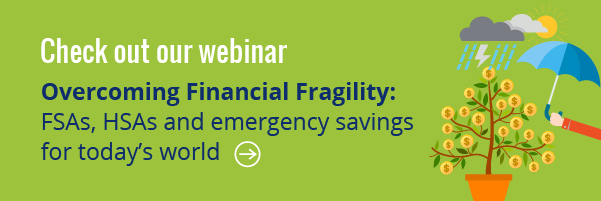COVID-19 has reminded HR teams of the importance of employee engagement with their consumer accounts.

As the front-line workers in helping their organization respond to COVID-19, HR teams have the challenging role of hearing directly from employees whose financial security has been shaken by decreased work hours, furloughs or layoffs.
“What am I supposed to do?” “How will I get by?” “Now more than ever, I need my benefits.” “I didn’t prepare for this!” Those are just a few of the more common employee concerns many HR pros are facing during their 9 to 5.
And the stress doesn’t stop after they shut down their laptops for the evening. Throughout the week, they may find themselves experiencing several or all stages of grief—denial, anger, depression, bargaining, and acceptance. Some may even experience guilt.
“Why am I the one who gets to keep her job? What could I have done better to prepare my employees for this sort of thing? How could I have protected them?
The Road Ahead
As our nation looks toward recovery, sociologists and economists agree that things may never go back to normal. We may continue to practice social distancing of one kind or another. We’ll certainly practice better health hygiene. And masks may be part of our new normal in protecting ourselves and our community.
As for financial protection, HR has an important role to play.
Armed with 20/20 hindsight, HR teams are in a unique position to help support their employee’s financial well-being going forward. In this blog, we’ve talked a lot about evaluating employee financial well-being programs. And Businessolver has published several thought leadership pieces on this topic as well. While many of the solutions we have discussed require a fair amount of preparation, many employers already have a program in place that can be easily enhanced—consumer accounts.
Engagement is Key
In understanding why employees don’t maximize their health savings accounts (HSAs), medical or dependent care flexible spending accounts (FSAs), emergency savings funds, or any other consumer accounts you’ve set up, it helps to know something about the behavioral economics at play. A few concepts to keep in mind:
- Value Priming - employees will enroll in the benefits they deem most valuable. But keep in mind that value changes from person to person. This is why it can be hard to communicate “value” when, for some, value is a savings vehicle and for others, it’s being able to pay for their middle-schooler’s orthodontics costs. Employees respond to different messages depending on their unique financial situation.
- Loss aversion - often it’s hard to convey the value of vague, “future needs.” People are more motivated by immediate needs over long-term planning. HR/benefits professionals need to break through the concept that employees are losing money out of their paychecks to fund these accounts and instead show the value and direct benefits of these consumer accounts. Using your data and personalizing your consumer account communications could turn the tide. For example, highlighting the tax benefits of an HSA or showcasing how a dependent care FSA can help with child or elder care.
- Choice Paralysis: it’s true, that everyone loves choice. But too many benefits options can cause employees to feel overwhelmed and opt for the most well-known or safest-feeling option that may not be the best fit for their goals.
Understanding and considering your employees’ behaviors and thought processes is key to creating a benefits engagement strategy that works and resonates with your workforce.
Learn More
Interested in thinking differently when it comes to consumer accounts? Join this Thursday’s webinar, Overcoming Financial Fragility to learn how to craft a holistic consumer accounts engagement strategy that includes:
- Tips for your COVID-19 response
- Incentives to maximize employee contributions
- Employee-friendly technology and communication tools



